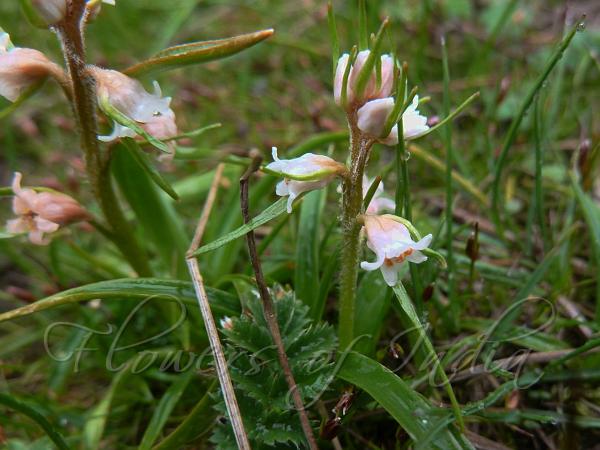|
| Few Flowered Colic-Root |
|

|

| File size | 387423 |
| Original date | 6/10/16 12:42 PM |
| Resolution | 1688 x 1266 |
| Flash | Flash did not fire, auto |
| Focal length | 4.1mm |
| Exposure time | 1/50s |
| Aperture | 3.3 |
| Focus Distance | |
| Metering Mode | Multi-segment |
| Camera make | Panasonic |
| Camera model | DMC-TZ10 |
| Sensor type | OneChipColorArea |
|
|
|
|
Photo: |
Botanical name: Aletris pauciflora Family: Nartheciaceae (Asphodel family)
Synonyms: Aletris nepalensis Hook.f. [Illeg.], Stachyopogon pauciflorus, Aletris delavayi
Synonyms: Aletris nepalensis Hook.f. [Illeg.], Stachyopogon pauciflorus, Aletris delavayi
Few Flowered Colic-Root is a small grass-like plant, growing up to 15 cm
tall. Leaves are linear-lanceshaped, prominently 5-7-nerved. Flowering
stem is naked, wooly-velvety above, longer than the leaves. Each flower
has 1-2, linear to narrowly lance-shaped bracts just below them, which are
much longer than the flowers. This feature distinguishes it from it close
cousin
Khasi Colic-Root which has bracts almost
equal to the flowers. In addition, Khasi Colic-Root's inflorescens is more
densely flowered. Flowers are hairless, pinkish, greenish or white,
stalkless or stalked, shortly bell-shaped. Petals are short, fused below,
turned back at the tip.
Stamens are 6, at the bases of the petals. Style shorter than the stamens,
with the stigma 3-parted. Fruit is capsular, ovoid, many seeded. Few
Flowered Colic-Root found in the Himalayas, from Kashmir to SW China, at
altitudes of 3400-4100 m. Flowering: June-August.
Medicinal uses: Aerial parts of the plant are used in lung and
liver disorders, respiratory diseases, pneumonia, bornchitis.
Aerial parts of the plant are used in lung and
liver disorders, respiratory diseases, pneumonia, bornchitis.
Medicinal uses:
 Aerial parts of the plant are used in lung and
liver disorders, respiratory diseases, pneumonia, bornchitis.
Aerial parts of the plant are used in lung and
liver disorders, respiratory diseases, pneumonia, bornchitis. | Identification credit: Tabish | Photographed beyond Tsomgo lake, Sikkim & Hemkund, Uttarakhand. |
• Is this flower misidentified? If yes,